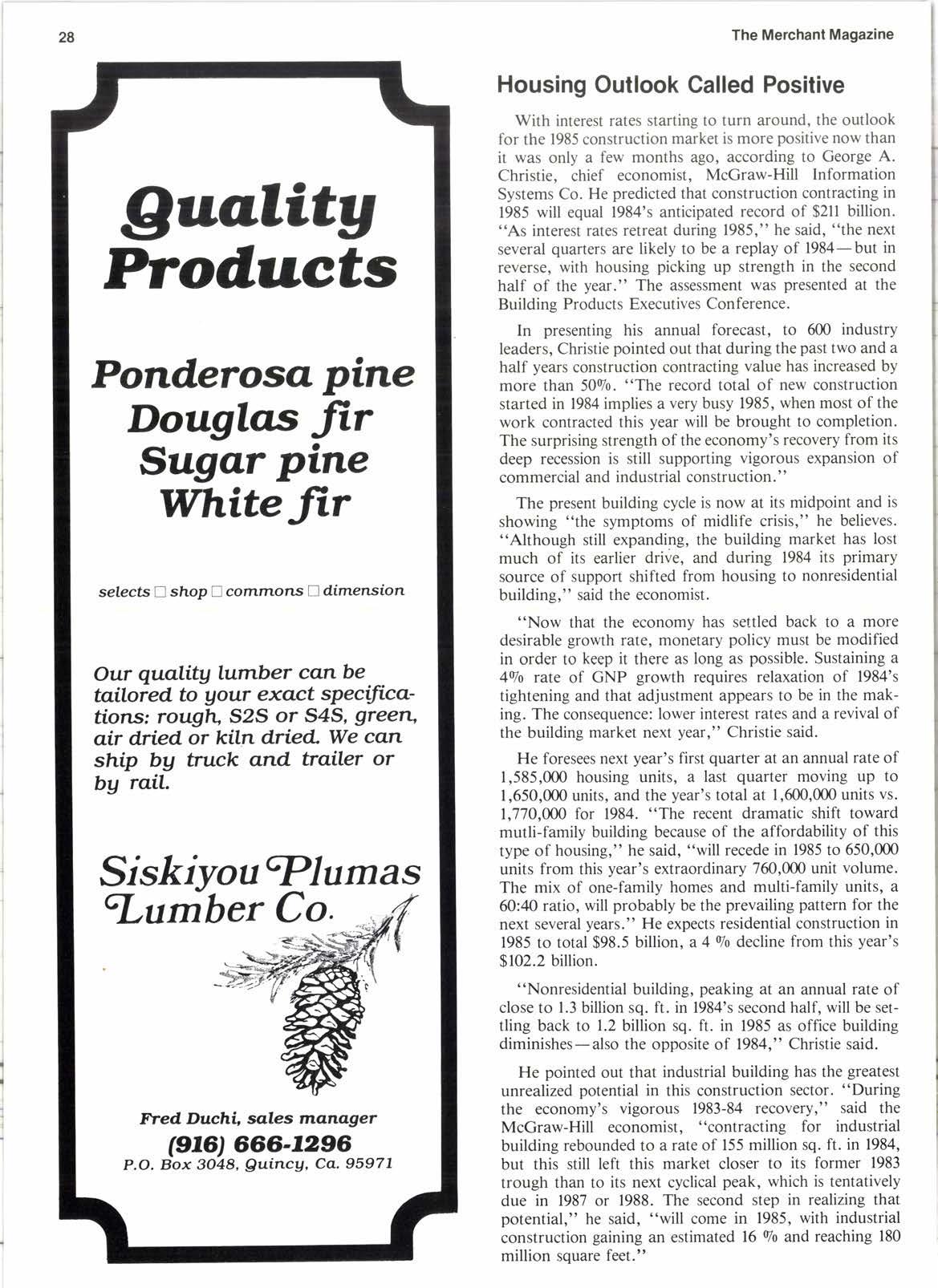
2 minute read
guo;litg Prloducts
Ponderosa. pine Douglas fir Sugar pineWhitefir
Our qualitg turnber co:rt. be taitored to gour exact sPecifica' tions; rougt\ S2S or S4S, greerl air dried or kiln dried We co,tr ship bg truck and trqiler or bg rait.
Housing Outlook Called Positive
With interest rates starting to turn around, the outlook for the 1985 construction market is more positive now than it was only a few months ago, according to George A. Christie, chief economist, McGraw-Hill Information Systems Co. He predicted that construction contracting in 1985 will equal 1984's anticipated record of $2ll billion. "As interest rates retreat during 1985," he said, "the next several quarters are likely to be a replay of 1984-but in reverse, with housing picking up strength in the second half of the year." The assessment was presented at the Building Products Executives Conference.
In presenting his annual forecast, to 600 industry leaders, Christie pointed out that during the past two and a half years construction contracting value has increased by more than 5090. "The record total of new construction started in 1984 implies a very busy 1985, when most of the work contracted this year will be brought to completion. The surprising strength of the economy's recovery from its deep recession is still supporting vigorous expansion of commercial and industrial construction."
The present building cycle is now at its midpoint and is showing "the symptoms of midlife crisis," he believes. "Although still expanding, the building market has lost much of its earlier drive, and during 1984 its primary source of support shifted from housing to nonresidential building," said the economist.
"Now that the economy has settled back to a more desirable growth rate, monetary policy must be modified in order to keep it there as long as possible. Sustaining a 4Vo rate of GNP growth requires relaxation of 1984's tightening and that adjustment appears to be in the making. The consequence: lower interest rates and a revival of the building market next year," Christie said.
He foresees next year's first quarter at an annual rate of 1,585,000 housing units, a last quarter moving up to 1,650,000 units, and the year's total at 1,600,000 units vs. 1,770,000 for 1984. "The recent dramatic shift toward mutli-family building because of the affordability of this type of housing," he said, "will recede in 1985 to 650,000 units from this year's extraordinary 760,000 unit volume. The mix of one-family homes and multi-family units, a 60:4O ratio, will probably be the prevailing pattern for the next several years." He expects residential construction in 1985 to total $98.5 billion, a 4 9o decline from this year's 5102.2 billion.
"Nonresidential building, peaking at an annual rate of close to 1.3 billion sq. ft. in 1984's second half, will be settling back to 1.2 billion sq. ft. in 1985 as office building diminishes-also the opposite of 1984," Christie said.
He pointed out that industrial building has the greatest unrealized potential in this construction sector. "During the economy's vigorous 1983-84 recovery," said the McGraw-Hill economist, "contracting for industrial building rebounded to a rate of 155 million sq. ft. in 1984, but this still left this market closer to its former 1983 trough than to its next cyclical peak, which is tentatively due in 1987 or 1988. The second step in realizing that potential," he said, "will come in 1985, with industrial construction gaining an estimated 16 9o and reaching 180 million square feet."










